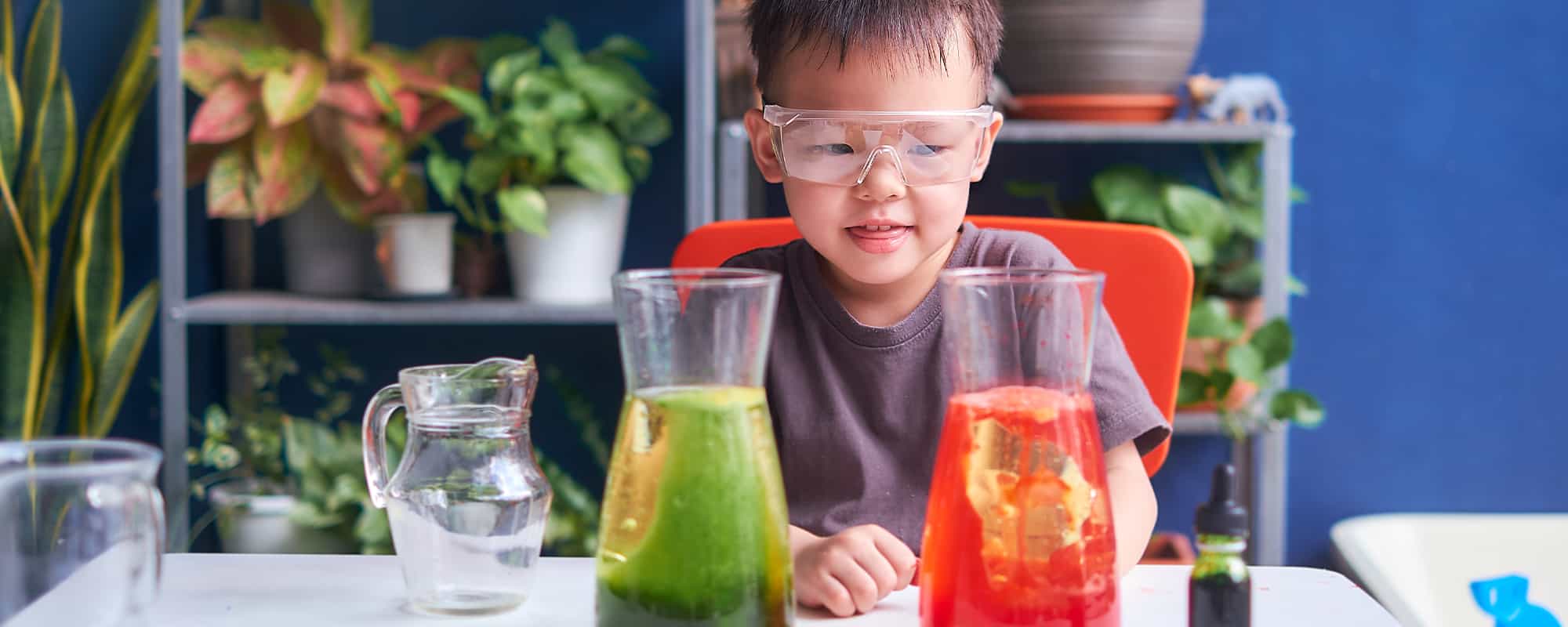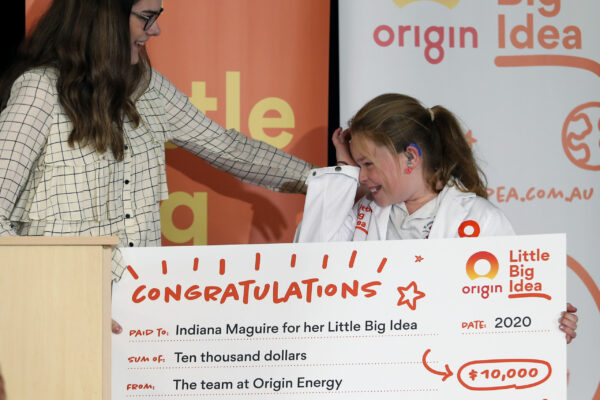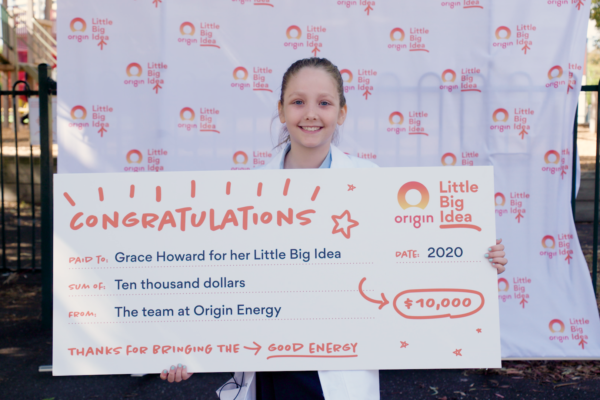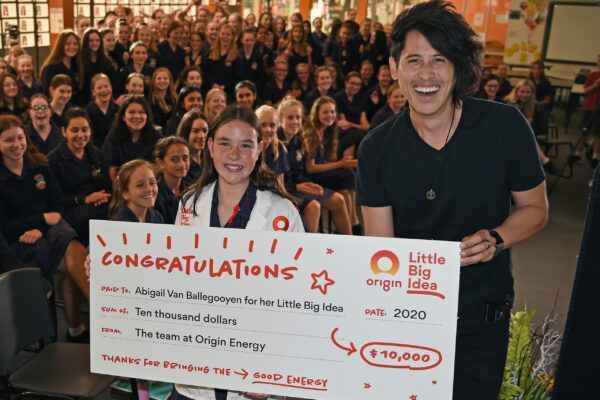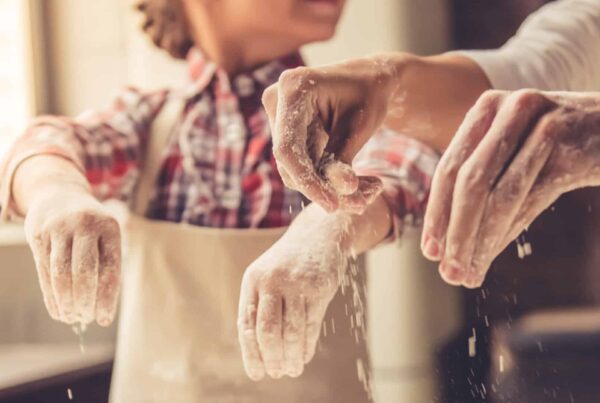Origin’s little BIG idea | Macinley Butson’s top five experiments for kids at home
To help uncover the next generation of young inventors, Origin’s Little Big Idea competition is asking Australian kids between grades three and eight to submit their ideas for their chance to win a $10,000 cash prize that can go towards their ongoing education, or to help turn their Little Big Idea into a reality!
Inventor and NSW Young Australian of the Year, Macinley Butson, has returned as a judge and ambassador for 2021. So to celebrate National Science Week, Macinley has shared her top five experiments for sparking creativity in kids at home – check them out below!
The Cloud Science Experiment
This is a great experiment to help kids understand how clouds and condensation work – plus it looks really cool!
What you need:
● 1 x jar
● Tap water
● Shaving foam
● Blue food colouring
● Pipette or glass dropper (if your food colouring doesn’t have one)
Activity:
1. Half fill jar with tap water.
2. Using the shaving foam, fill the rest of the jar with shaving cream to create a cloud.
3. Let the foam settle for a moment.
4. Now drop the food colouring into the ‘cloud’. As your cloud fills up, the food colouring will fall down into the water creating a rain-like effect.
Elephant Toothpaste
Ever wondered how much toothpaste you need to clean an elephant’s teeth? I love this experiment for kids, it’s fun, though a little messy, so best to do it outside!
What you need:
● Empty plastic bottle
● 1 x tbsp of dry yeast
● 3 x tbsp of warm water
● Liquid dish soap
● ½ cup hydrogen peroxide (you can purchase this substance from your local pharmacy)
● Food colouring
● Safety goggles
Activity:
1. Pour the hydrogen peroxide into the empty plastic bottle.
2. Add a big squirt of liquid dish soap to the bottle and a few drops of food colouring and give it a gentle swirl to mix.
3. In a measuring cup, mix together the yeast and warm water, stirring for about 30 seconds.
4. Pour the yeast mixture into the bottle and quickly step back!
Slime Chemistry
This experiment is a great example for the study of matter, which is what everything around you is made of! By making slime you’re able to see how the materials are mixed and how they behave as a result.
What you need:
● 1 cup of PVA glue
● 1 tablespoon baking soda
● 1 ½ – 2 tablespoons contact lense solution
● Food colouring
Activity:
1. Mix together PVA and food colouring into a bowl and stir to combine, then mix in the baking soda.
2. Add 1 ½ tablespoons of the contact lens solution and mix until combined. If it’s too sticky, add ½ tablespoon of solution at time.
3. Using your hands, knead the slime until it holds together!
Lava Lamp Experiment
This experiment shows kids the weight and properties of different substances. They don’t mix because of intermolecular polarity
What you need:
● Plastic water (preferably with smooth sides)
● Water
● Vegetable Oil
● Aspirin tablets
● Food colouring
Activity:
1. Fill water bottle a quarter full with water.
2. Pour in vegetable oil until the bottle is almost full.
3. Add a few drops of food colouring.
4. Break your aspirin tablets into half and drop half into the bottle and watch the bubble blobs form! Shine a torch for the extra lava lamp effect!
Cool Crystals
This experiment is a good one for kids who are interested in molecules and atoms. Molecules and atoms are too small to see with the naked eye, however the arrangements of the crystals form what molecules and atoms would look like.
What you need:
● ¼ cup epsom salt
● ¼ cup hot water
● Food colouring
Activity:
1. Mix together ¼ cup of epsom salt and ¼ hot water from the skin until the salt has dissolved.
2. Once the salt is dissolved, add in a couple of drops of food colouring in the cup and stir to mix.
3. Place the cup in the fridge, checking every half and hour to hour. Within 4 hours crystals should form at the bottom of the cup!
Macinley is currently an ambassador for Origin Energy’s Little Big Idea competition, encouraging young inventors to share their creative ideas and inventions for the chance to win a $10,000 prize.
Find out more about Origin Energy’s Little Big Idea competition at www.littlebigidea.com.au

